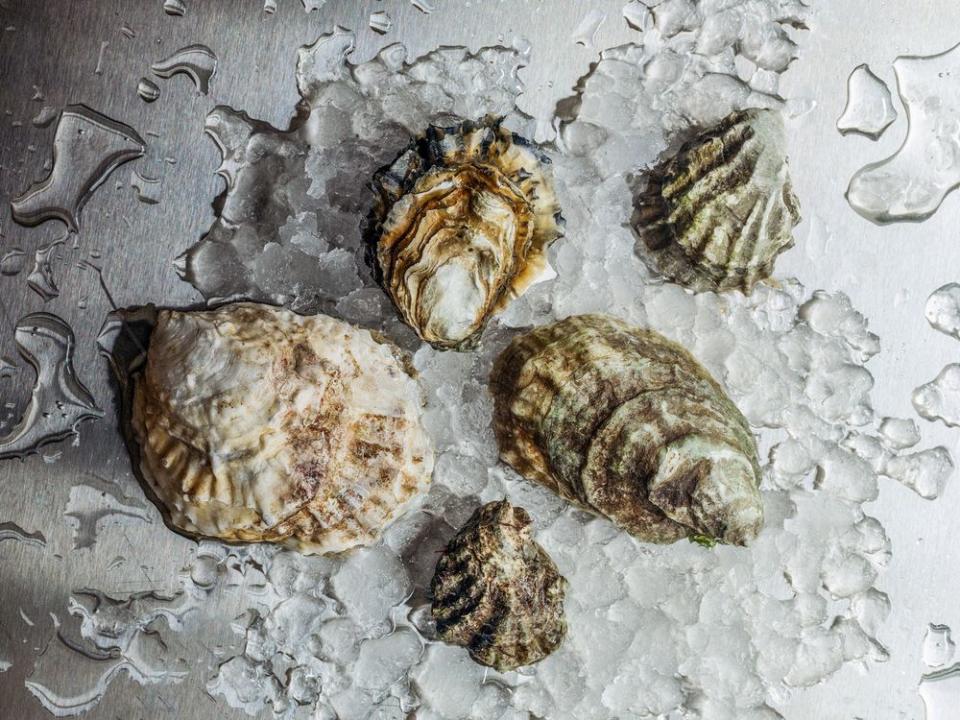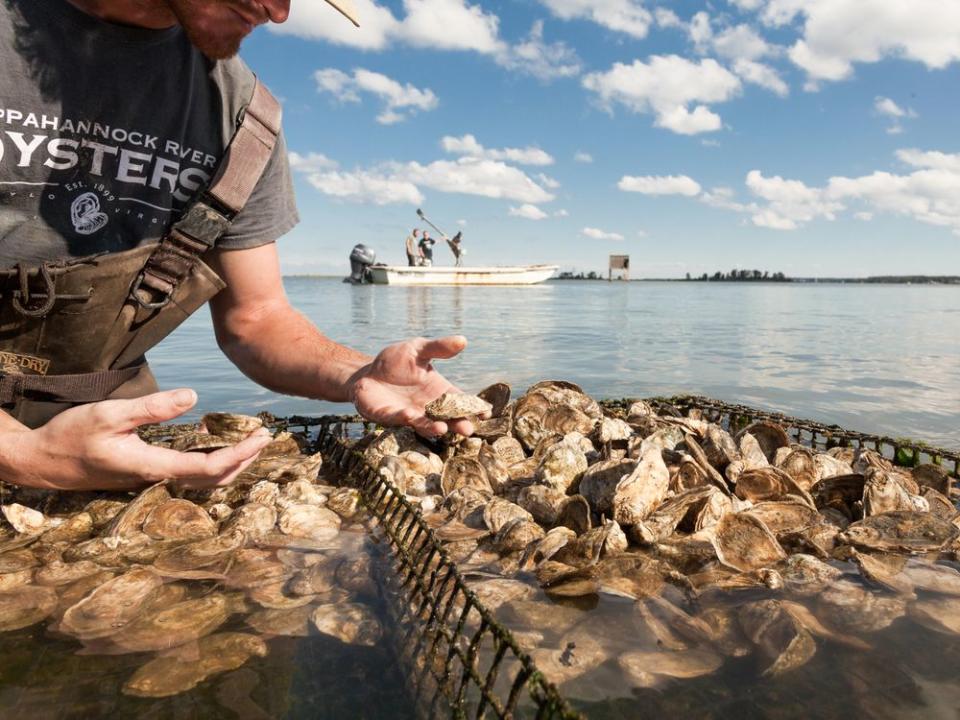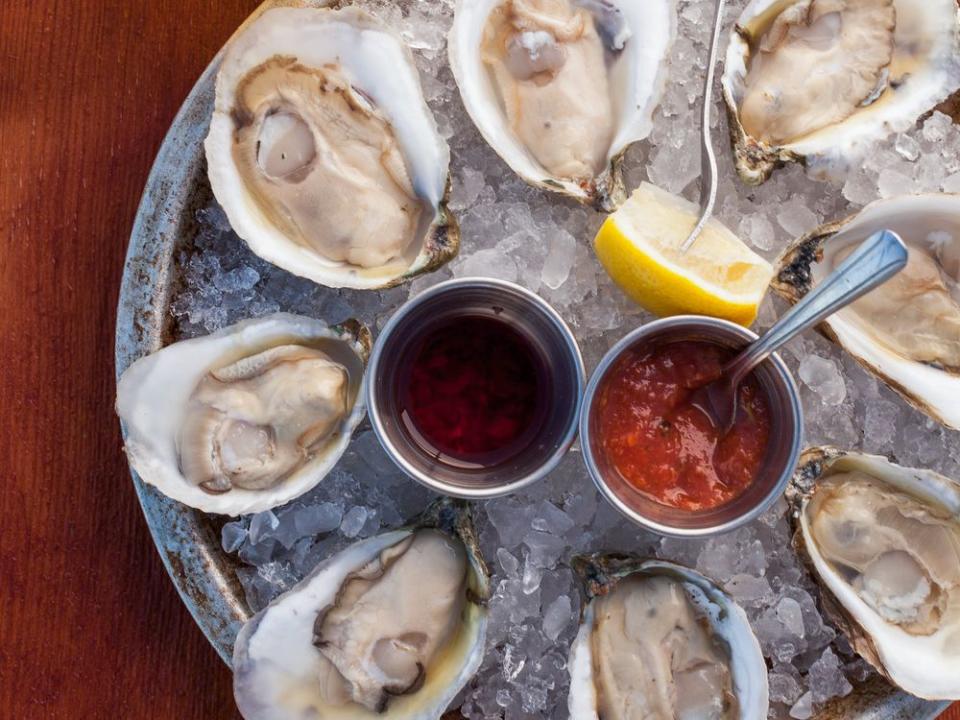How to Talk About Oysters Like You Know What You're Talking About
Had McDonald’s opened shop in the 1850s, it probably would have served oysters rather than burgers.
The bivalves have been a staple in American diets dating back to well before Europeans stepped foot on the continent. An oyster-shell mound, known as a midden, left by the Timucua in North Florida has shells dating from 600 to 2,500 years ago. Another midden, on the upper Damariscotta River in Maine, contains shells consumed by Etchemins between 2,200 and 1,000 years back.

By the time Europeans were coming to North America in droves during the 1800s, the country found itself in the middle of a “great oyster craze.” The mollusks were so popular among 19th-century settlers, they were included in dozens of recipes—everything from stewed and pickled to stuffed inside turkey or scrambled eggs—across hundreds of cookbooks up and down the coasts and throughout the Midwest. “Oyster cellars were all over the country—even inland places like Kansas City,” says Travis Croxton, co-owner of Virginia-based Rappahannock Oyster Co. “They were the Starbucks of their day.”
By the early 1900s, overharvesting and water pollution decimated many of the wild oyster beds around the United States. And more than a century later, oyster populations are still at historic lows.
These days shellfish aquaculture is booming thanks to sustainable farmers like cousins Travis and Ryan Croxton, who revived their family’s 19th-century oyster business, Rappahannock Oyster Co., back in 2001. As of 2016, U.S. aquaculturists produced 37 million pounds of the sustainable bivalve worth $192 million. And those numbers are expected to keep on rising.
Clearly, Americans are getting back their hankering for oysters, just like much of the rest of the planet.
There are actually over 200 different species of oysters spread throughout the world; however, just five are commercial harvested, grown, and sold in the United States. “There are plenty of others in Asia; Australia has native varieties,” says Ryan. “You won’t find them here. The big five is a very Eurocentric viewpoint.”
Here are the big five, so you know what exactly you’re slurping.

Pacific Oysters (Crassostrea Gigas)
Gigas, known as Pacific oysters, were brought to the United States from Japan in the 1920s to replace Washington State’s dwindling stock of native Olympic oysters (more on those in a bit). They grow and reproduce quickly, reaching market size in about two years. The meat skews firm and crisp. The attractive shell is consistently fluted with a deep cup that many chefs and consumers prefer. All of those factors have made Pacifics the most popular oyster around the world, grown all throughout the Pacific as well as Norway, France, Morocco, and Namibia. “They’re a workhorse,” Ryan says. “You can find them in most major regions.”
Like all oysters, the flavor changes drastically depending on the water in which it’s grown and the time of year; however, Pacifics tend to taste mild, slightly sweet with fruit and vegetable notes as well as a good amount of brine and, often, a bit of metal. “Melon” is a word that gets thrown around a lot when tasting Pacific oysters from the West Coast.
The predominant oysters grown on the West Coast of North America, Pacifics are often named after the place where they are raised, such as Tomales Bay in Northern California and Totten Inlet in Fanny Bay, British Columbia. But farmers will occasionally use their own proprietary names for their crop, such as Morro Bay Oyster Company’s Pacific Golds and Hog Island Oyster Company’s Sweetwaters.
At times, aquaculturists will use other names for their Pacifics depending on the growing method used. Tide-tumbled oysters, what some folks refer to as a “reserve” oyster due to the even deeper cup and more flavorful meat are often given different monikers. For example, Baja Shellfish Farm out of Mexico calls their tumbled Pacifics Kumiai Oysters while Hama Hama has dubbed theirs Blue Pool.
Atlantic or Eastern Oysters (Crassostrea Virginicas)
Since 1990, an average of 78 percent of all wild oysters harvested on the planet have been Atlantic oysters, with a whopping 66 percent of them hailing from the United States. The Atlantic oyster is native to entire the Atlantic coast of North America and into the Gulf of Mexico.
Like Pacific oysters, Atlantics grow and reproduce quickly. In warmer waters, they can reach market size in around 18 months and get up to eight inches long. But they are distinctly different from their West Coast cousins, with a larger tear-drop shape, smoother shell, and, while generally described as sweeter and brinier than Pacifics, the flavors vary drastically according to the water temperature and the individual bed in which they are grown.
The Croxton’s crop out of Virginia is a prime example of the wide-ranging, distinct flavor variations of the Atlantic. Their Rappahannock River oysters are sweet and buttery with full-bodied taste infused with rich minerality from the freshwater that washes down from the Blue Ridge Mountains and just a hint of salt. The Rochambeaus, grown nearby in the brackish water where the York River meets the Chesapeake Bay, are a bit saltier, slightly less sweet, and cleaner on the palate. The Olde Salts, reared in the salty waters of Chincoteague Bay, off Virginia’s Eastern Shore, taste like being splashed in the face by a wave, full of brine with a clean, smooth finish. “All the different things in the environment combine to make a radically different oyster,” Travis says. “The oysters are exactly the same, just grown in different places.”
Rappahannock brands their oysters according to the location where they’re grown as is also common for most Atlantic Oysters including well-known Wellfleets from Wellfleet Bay in Massachusetts, Malpeques from Malpeque Bay in Prince Edward Island and Bluepoints from the Long Island Sound.
A general rule of thumb with Atlantic oysters is the farther north they’re grown, the brinier the flavor. “The biggest differentiator is salt,” Ryan says. “The farther up the East Coast, almost everything is grown in the ocean: there’s not a lot of estuaries.”

Kumamoto Oysters (Crassostrea Sikamea)
Kumamotos have a lot in common with Pacific oysters. Their appearance is similar, with deep cups and fluted, pointy shells. They’re both cultivated on North America’s Pacific Coast, often boasting a sweet, fruity flavor.
Kumamotos take a lot longer to grow, three years opposed to just two, and are significantly smaller. What they lack in size, they make up for in flavor. Their semi-firm meat tends to be very sweet, often melony, with more nuanced floral notes.
These mild, little flavor bombs are highly prized by chefs and consumers—the compact size and salty, sweetness makes them an easy sell for oyster novices—they’re pretty much always named by their species on menus, though some farmers may also specify where they were grown as well.
Olympia Oysters (Ostrea Lurida and Ostrea Conchapila)
Olympia oysters, the only oyster indigenous to the West Coast of North America, were decimated in the early 20th century due to pollution and overharvesting.
Wild populations do exist today but are stringently protected. In Washington State, for example, Olympia oysters must have a shell that is at least 2.5 inches long to meet its recreational harvest criteria, which is tough considering the majority of the ones sold commercially—and take three to five years to reach maturity—are only about the size of a 50-cent piece. “They’re slow growers and not that meaty,” says Ryan, who knows of fewer than a handful West Coast growers working with the species. “It’s a really unique flavor, very coppery, like a French Belon, with a similar earthiness, kind of pungent.”
Washington State aquaculturists, including Taylor Shellfish, Chelsea Farms, and Jones Family Farm, have been bringing them back, selling them to restaurants and directly to customers on the web.
European Flats (Ostrea Edulis)
European Flat oysters are native to the western European coast, stretching all the way from Norway to Morocco and into the Mediterranean. The smooth, saucer-like species is often referred to as Belons, but technically they should only be called Belons when they are grown near the Belon River in Brittany, France. (In the U.S., the North American-grown crop are named Belons anyway.)
Back in the 1950s, European Flats seeds were purposely introduced to Maine from the Netherlands in hopes of bolstering North America’s oyster supply, but the fickle species did not take off as hoped and efforts to farm them were quickly abandoned. A decade later, wild populations began to grow along the New England coast.
The moss-colored, flat-shelled oyster is now harvested wild in New England and is farmed both in Maine as well as Washington State to a much smaller extent. The meaty, almost crisp meat has an intense minerality with strong, umami-laden seaweed notes and a long-lasting finish some would describe as gamey, the boldest flavor of all the oyster species.
It is not considered a beginners variety. “It’s very memorable,” says Travis. “If you put out in front of ten people, eight would hate it and two would think it is the greatest thing they had in their life: it’s earthy and tastes like a car bumper—in a good way.”

